Research Paper: Cyber Issues in Smart Home Appliances of IoT
VerifiedAdded on 2022/08/22
|26
|7130
|13
Report
AI Summary
This research paper investigates the cybersecurity challenges associated with smart home appliances within the Internet of Things (IoT) ecosystem. The study begins by introducing the increasing prevalence of smart home devices and the vulnerabilities they introduce, including data breaches and cyber-attacks. It highlights the core problem of securing these devices, which often handle sensitive user information. The research aims to analyze the privacy and security issues in IoT-driven smart home appliances, identifying key elements of smart home automation systems (SHAS) and the interactions between these elements. The objectives include determining the major security concerns, identifying threats related to each element, and evaluating their impact on users. The literature review explores security goals like confidentiality, integrity, and availability, along with potential attacks and security standards. The study also examines the significance of securing IoT devices, emphasizing the need for robust security solutions to protect user data. The report concludes with recommendations for enhancing smart home appliance security and mitigating identified threats.
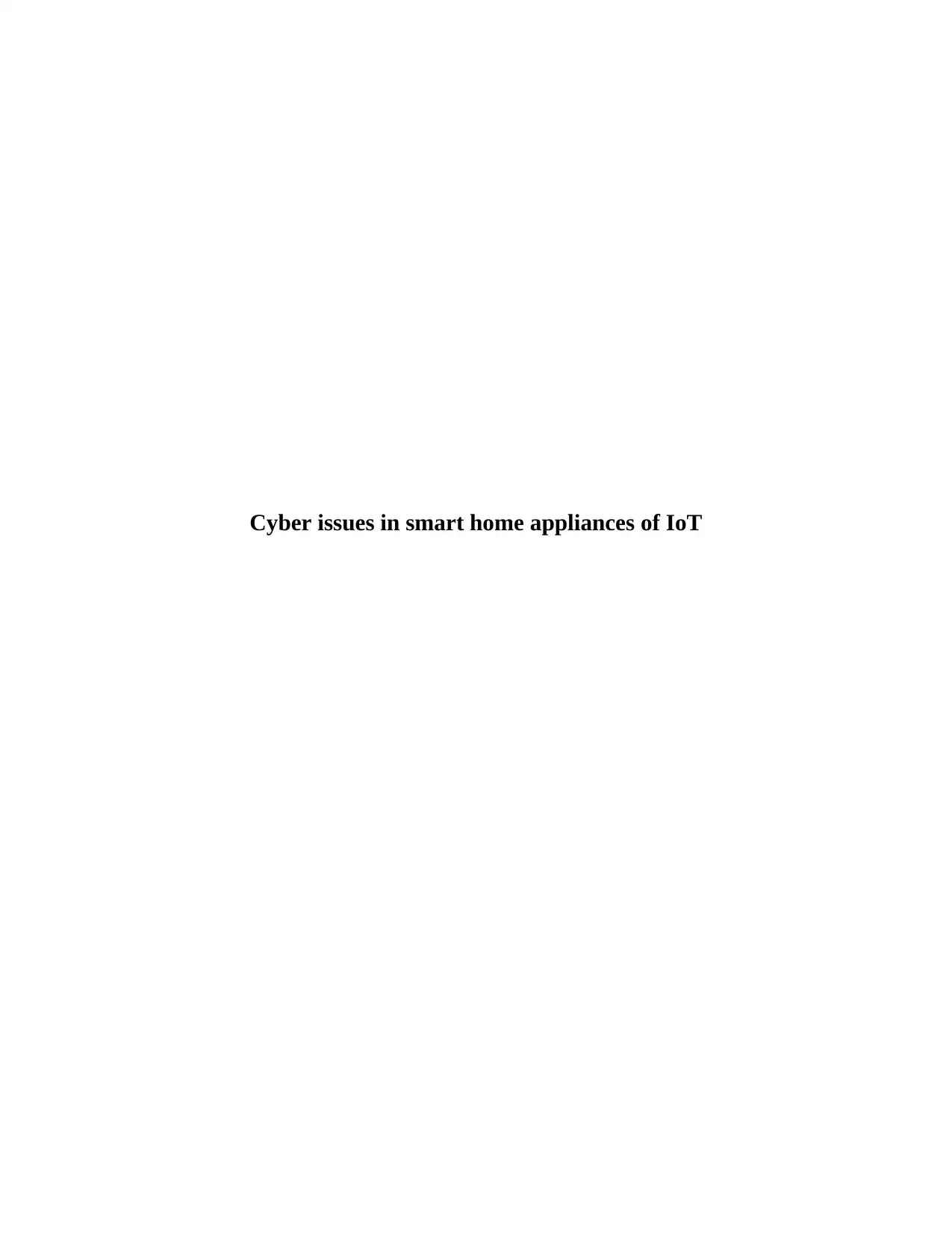
Cyber issues in smart home appliances of IoT
Paraphrase This Document
Need a fresh take? Get an instant paraphrase of this document with our AI Paraphraser
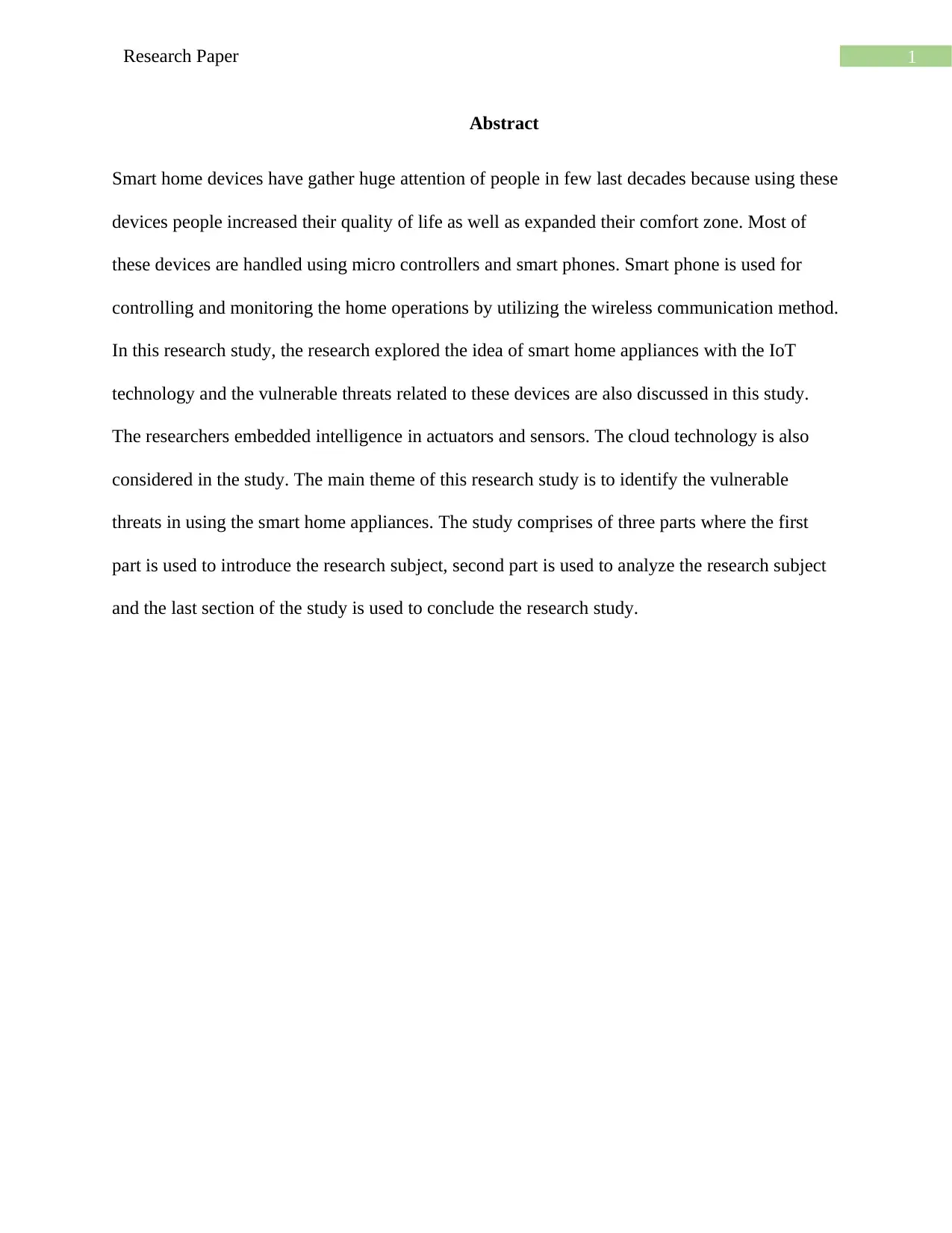
1Research Paper
Abstract
Smart home devices have gather huge attention of people in few last decades because using these
devices people increased their quality of life as well as expanded their comfort zone. Most of
these devices are handled using micro controllers and smart phones. Smart phone is used for
controlling and monitoring the home operations by utilizing the wireless communication method.
In this research study, the research explored the idea of smart home appliances with the IoT
technology and the vulnerable threats related to these devices are also discussed in this study.
The researchers embedded intelligence in actuators and sensors. The cloud technology is also
considered in the study. The main theme of this research study is to identify the vulnerable
threats in using the smart home appliances. The study comprises of three parts where the first
part is used to introduce the research subject, second part is used to analyze the research subject
and the last section of the study is used to conclude the research study.
Abstract
Smart home devices have gather huge attention of people in few last decades because using these
devices people increased their quality of life as well as expanded their comfort zone. Most of
these devices are handled using micro controllers and smart phones. Smart phone is used for
controlling and monitoring the home operations by utilizing the wireless communication method.
In this research study, the research explored the idea of smart home appliances with the IoT
technology and the vulnerable threats related to these devices are also discussed in this study.
The researchers embedded intelligence in actuators and sensors. The cloud technology is also
considered in the study. The main theme of this research study is to identify the vulnerable
threats in using the smart home appliances. The study comprises of three parts where the first
part is used to introduce the research subject, second part is used to analyze the research subject
and the last section of the study is used to conclude the research study.
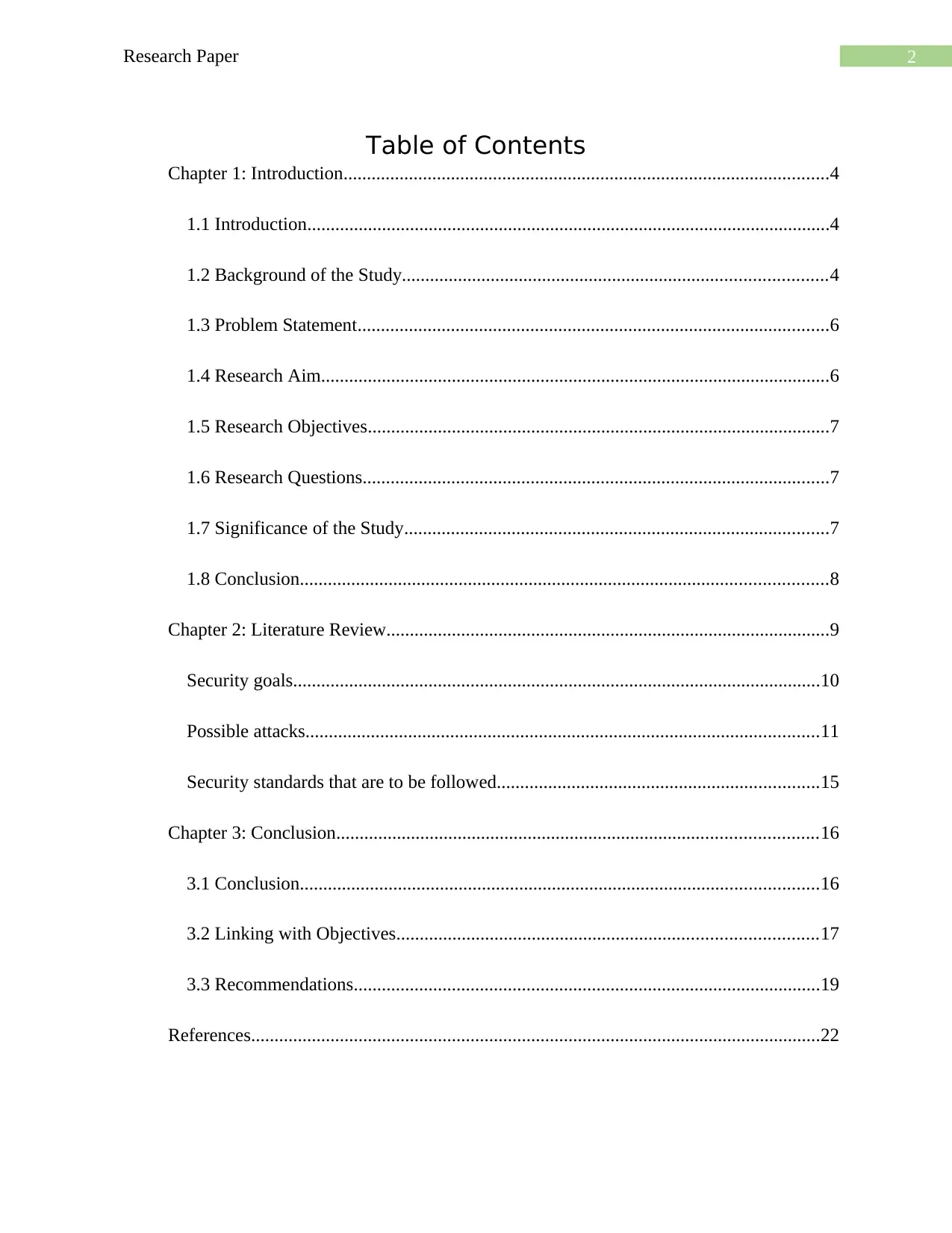
2Research Paper
Table of Contents
Chapter 1: Introduction........................................................................................................4
1.1 Introduction................................................................................................................4
1.2 Background of the Study...........................................................................................4
1.3 Problem Statement.....................................................................................................6
1.4 Research Aim.............................................................................................................6
1.5 Research Objectives...................................................................................................7
1.6 Research Questions....................................................................................................7
1.7 Significance of the Study...........................................................................................7
1.8 Conclusion.................................................................................................................8
Chapter 2: Literature Review...............................................................................................9
Security goals.................................................................................................................10
Possible attacks..............................................................................................................11
Security standards that are to be followed.....................................................................15
Chapter 3: Conclusion.......................................................................................................16
3.1 Conclusion...............................................................................................................16
3.2 Linking with Objectives..........................................................................................17
3.3 Recommendations....................................................................................................19
References..........................................................................................................................22
Table of Contents
Chapter 1: Introduction........................................................................................................4
1.1 Introduction................................................................................................................4
1.2 Background of the Study...........................................................................................4
1.3 Problem Statement.....................................................................................................6
1.4 Research Aim.............................................................................................................6
1.5 Research Objectives...................................................................................................7
1.6 Research Questions....................................................................................................7
1.7 Significance of the Study...........................................................................................7
1.8 Conclusion.................................................................................................................8
Chapter 2: Literature Review...............................................................................................9
Security goals.................................................................................................................10
Possible attacks..............................................................................................................11
Security standards that are to be followed.....................................................................15
Chapter 3: Conclusion.......................................................................................................16
3.1 Conclusion...............................................................................................................16
3.2 Linking with Objectives..........................................................................................17
3.3 Recommendations....................................................................................................19
References..........................................................................................................................22
⊘ This is a preview!⊘
Do you want full access?
Subscribe today to unlock all pages.

Trusted by 1+ million students worldwide

3Research Paper
Paraphrase This Document
Need a fresh take? Get an instant paraphrase of this document with our AI Paraphraser
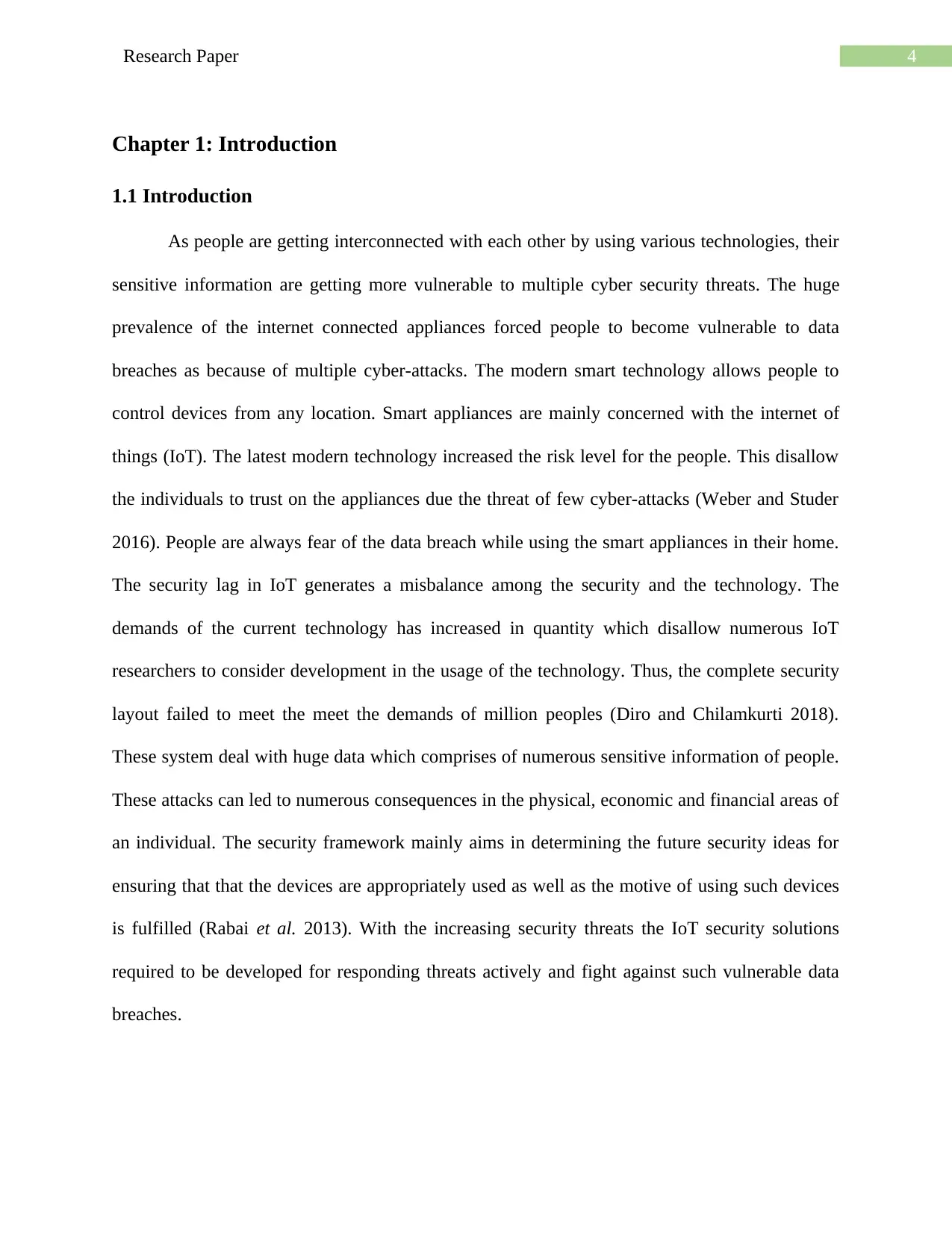
4Research Paper
Chapter 1: Introduction
1.1 Introduction
As people are getting interconnected with each other by using various technologies, their
sensitive information are getting more vulnerable to multiple cyber security threats. The huge
prevalence of the internet connected appliances forced people to become vulnerable to data
breaches as because of multiple cyber-attacks. The modern smart technology allows people to
control devices from any location. Smart appliances are mainly concerned with the internet of
things (IoT). The latest modern technology increased the risk level for the people. This disallow
the individuals to trust on the appliances due the threat of few cyber-attacks (Weber and Studer
2016). People are always fear of the data breach while using the smart appliances in their home.
The security lag in IoT generates a misbalance among the security and the technology. The
demands of the current technology has increased in quantity which disallow numerous IoT
researchers to consider development in the usage of the technology. Thus, the complete security
layout failed to meet the meet the demands of million peoples (Diro and Chilamkurti 2018).
These system deal with huge data which comprises of numerous sensitive information of people.
These attacks can led to numerous consequences in the physical, economic and financial areas of
an individual. The security framework mainly aims in determining the future security ideas for
ensuring that that the devices are appropriately used as well as the motive of using such devices
is fulfilled (Rabai et al. 2013). With the increasing security threats the IoT security solutions
required to be developed for responding threats actively and fight against such vulnerable data
breaches.
Chapter 1: Introduction
1.1 Introduction
As people are getting interconnected with each other by using various technologies, their
sensitive information are getting more vulnerable to multiple cyber security threats. The huge
prevalence of the internet connected appliances forced people to become vulnerable to data
breaches as because of multiple cyber-attacks. The modern smart technology allows people to
control devices from any location. Smart appliances are mainly concerned with the internet of
things (IoT). The latest modern technology increased the risk level for the people. This disallow
the individuals to trust on the appliances due the threat of few cyber-attacks (Weber and Studer
2016). People are always fear of the data breach while using the smart appliances in their home.
The security lag in IoT generates a misbalance among the security and the technology. The
demands of the current technology has increased in quantity which disallow numerous IoT
researchers to consider development in the usage of the technology. Thus, the complete security
layout failed to meet the meet the demands of million peoples (Diro and Chilamkurti 2018).
These system deal with huge data which comprises of numerous sensitive information of people.
These attacks can led to numerous consequences in the physical, economic and financial areas of
an individual. The security framework mainly aims in determining the future security ideas for
ensuring that that the devices are appropriately used as well as the motive of using such devices
is fulfilled (Rabai et al. 2013). With the increasing security threats the IoT security solutions
required to be developed for responding threats actively and fight against such vulnerable data
breaches.
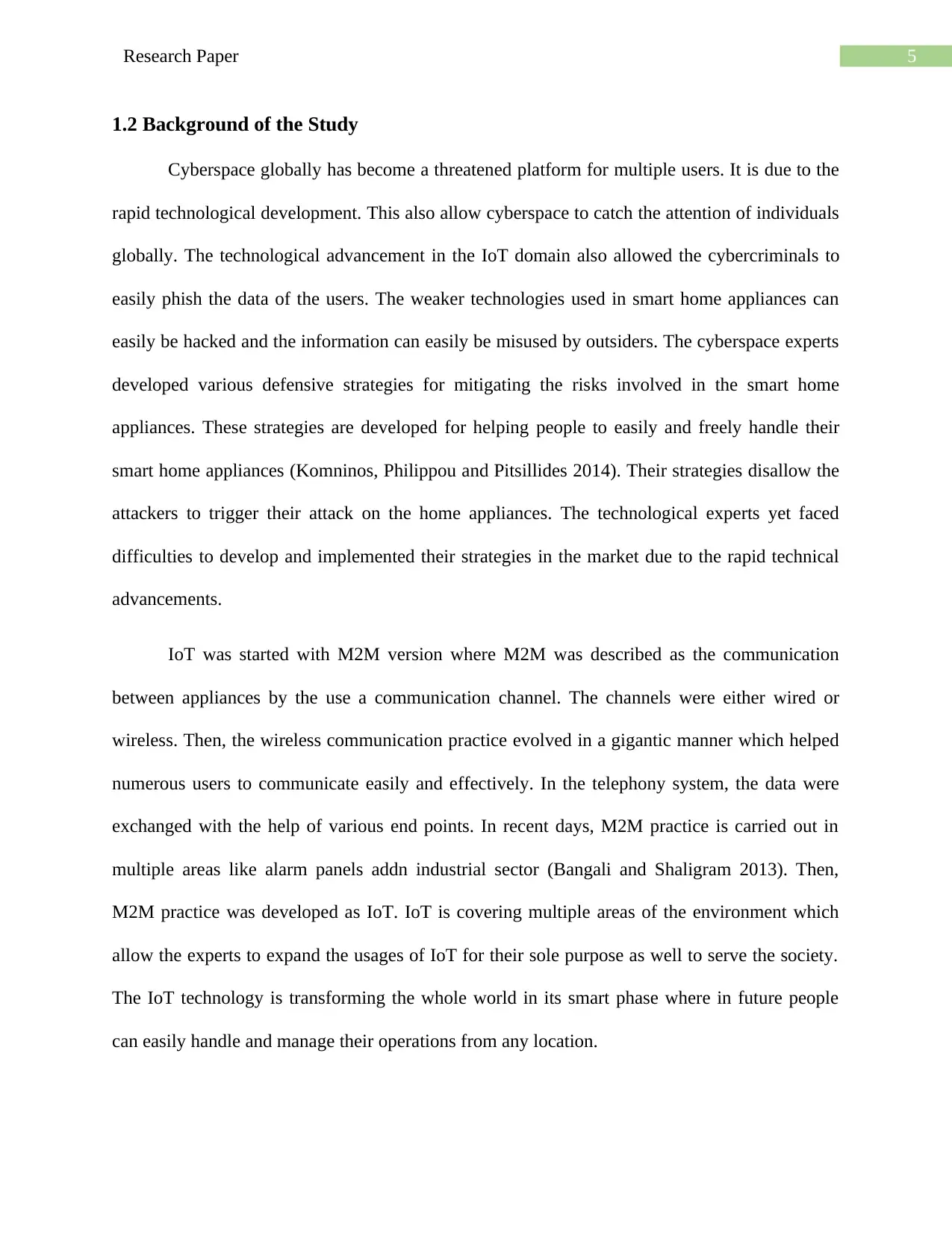
5Research Paper
1.2 Background of the Study
Cyberspace globally has become a threatened platform for multiple users. It is due to the
rapid technological development. This also allow cyberspace to catch the attention of individuals
globally. The technological advancement in the IoT domain also allowed the cybercriminals to
easily phish the data of the users. The weaker technologies used in smart home appliances can
easily be hacked and the information can easily be misused by outsiders. The cyberspace experts
developed various defensive strategies for mitigating the risks involved in the smart home
appliances. These strategies are developed for helping people to easily and freely handle their
smart home appliances (Komninos, Philippou and Pitsillides 2014). Their strategies disallow the
attackers to trigger their attack on the home appliances. The technological experts yet faced
difficulties to develop and implemented their strategies in the market due to the rapid technical
advancements.
IoT was started with M2M version where M2M was described as the communication
between appliances by the use a communication channel. The channels were either wired or
wireless. Then, the wireless communication practice evolved in a gigantic manner which helped
numerous users to communicate easily and effectively. In the telephony system, the data were
exchanged with the help of various end points. In recent days, M2M practice is carried out in
multiple areas like alarm panels addn industrial sector (Bangali and Shaligram 2013). Then,
M2M practice was developed as IoT. IoT is covering multiple areas of the environment which
allow the experts to expand the usages of IoT for their sole purpose as well to serve the society.
The IoT technology is transforming the whole world in its smart phase where in future people
can easily handle and manage their operations from any location.
1.2 Background of the Study
Cyberspace globally has become a threatened platform for multiple users. It is due to the
rapid technological development. This also allow cyberspace to catch the attention of individuals
globally. The technological advancement in the IoT domain also allowed the cybercriminals to
easily phish the data of the users. The weaker technologies used in smart home appliances can
easily be hacked and the information can easily be misused by outsiders. The cyberspace experts
developed various defensive strategies for mitigating the risks involved in the smart home
appliances. These strategies are developed for helping people to easily and freely handle their
smart home appliances (Komninos, Philippou and Pitsillides 2014). Their strategies disallow the
attackers to trigger their attack on the home appliances. The technological experts yet faced
difficulties to develop and implemented their strategies in the market due to the rapid technical
advancements.
IoT was started with M2M version where M2M was described as the communication
between appliances by the use a communication channel. The channels were either wired or
wireless. Then, the wireless communication practice evolved in a gigantic manner which helped
numerous users to communicate easily and effectively. In the telephony system, the data were
exchanged with the help of various end points. In recent days, M2M practice is carried out in
multiple areas like alarm panels addn industrial sector (Bangali and Shaligram 2013). Then,
M2M practice was developed as IoT. IoT is covering multiple areas of the environment which
allow the experts to expand the usages of IoT for their sole purpose as well to serve the society.
The IoT technology is transforming the whole world in its smart phase where in future people
can easily handle and manage their operations from any location.
⊘ This is a preview!⊘
Do you want full access?
Subscribe today to unlock all pages.

Trusted by 1+ million students worldwide
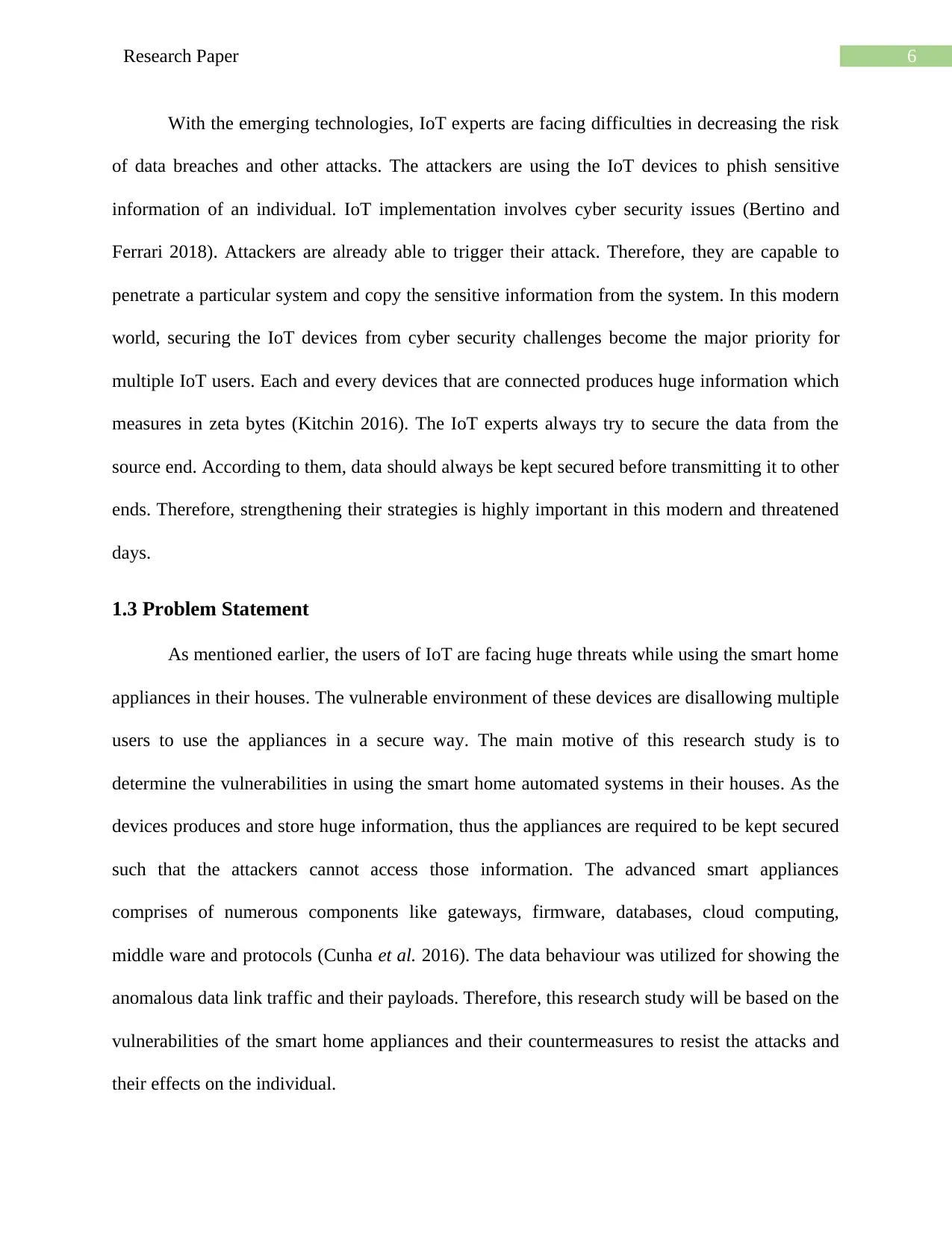
6Research Paper
With the emerging technologies, IoT experts are facing difficulties in decreasing the risk
of data breaches and other attacks. The attackers are using the IoT devices to phish sensitive
information of an individual. IoT implementation involves cyber security issues (Bertino and
Ferrari 2018). Attackers are already able to trigger their attack. Therefore, they are capable to
penetrate a particular system and copy the sensitive information from the system. In this modern
world, securing the IoT devices from cyber security challenges become the major priority for
multiple IoT users. Each and every devices that are connected produces huge information which
measures in zeta bytes (Kitchin 2016). The IoT experts always try to secure the data from the
source end. According to them, data should always be kept secured before transmitting it to other
ends. Therefore, strengthening their strategies is highly important in this modern and threatened
days.
1.3 Problem Statement
As mentioned earlier, the users of IoT are facing huge threats while using the smart home
appliances in their houses. The vulnerable environment of these devices are disallowing multiple
users to use the appliances in a secure way. The main motive of this research study is to
determine the vulnerabilities in using the smart home automated systems in their houses. As the
devices produces and store huge information, thus the appliances are required to be kept secured
such that the attackers cannot access those information. The advanced smart appliances
comprises of numerous components like gateways, firmware, databases, cloud computing,
middle ware and protocols (Cunha et al. 2016). The data behaviour was utilized for showing the
anomalous data link traffic and their payloads. Therefore, this research study will be based on the
vulnerabilities of the smart home appliances and their countermeasures to resist the attacks and
their effects on the individual.
With the emerging technologies, IoT experts are facing difficulties in decreasing the risk
of data breaches and other attacks. The attackers are using the IoT devices to phish sensitive
information of an individual. IoT implementation involves cyber security issues (Bertino and
Ferrari 2018). Attackers are already able to trigger their attack. Therefore, they are capable to
penetrate a particular system and copy the sensitive information from the system. In this modern
world, securing the IoT devices from cyber security challenges become the major priority for
multiple IoT users. Each and every devices that are connected produces huge information which
measures in zeta bytes (Kitchin 2016). The IoT experts always try to secure the data from the
source end. According to them, data should always be kept secured before transmitting it to other
ends. Therefore, strengthening their strategies is highly important in this modern and threatened
days.
1.3 Problem Statement
As mentioned earlier, the users of IoT are facing huge threats while using the smart home
appliances in their houses. The vulnerable environment of these devices are disallowing multiple
users to use the appliances in a secure way. The main motive of this research study is to
determine the vulnerabilities in using the smart home automated systems in their houses. As the
devices produces and store huge information, thus the appliances are required to be kept secured
such that the attackers cannot access those information. The advanced smart appliances
comprises of numerous components like gateways, firmware, databases, cloud computing,
middle ware and protocols (Cunha et al. 2016). The data behaviour was utilized for showing the
anomalous data link traffic and their payloads. Therefore, this research study will be based on the
vulnerabilities of the smart home appliances and their countermeasures to resist the attacks and
their effects on the individual.
Paraphrase This Document
Need a fresh take? Get an instant paraphrase of this document with our AI Paraphraser
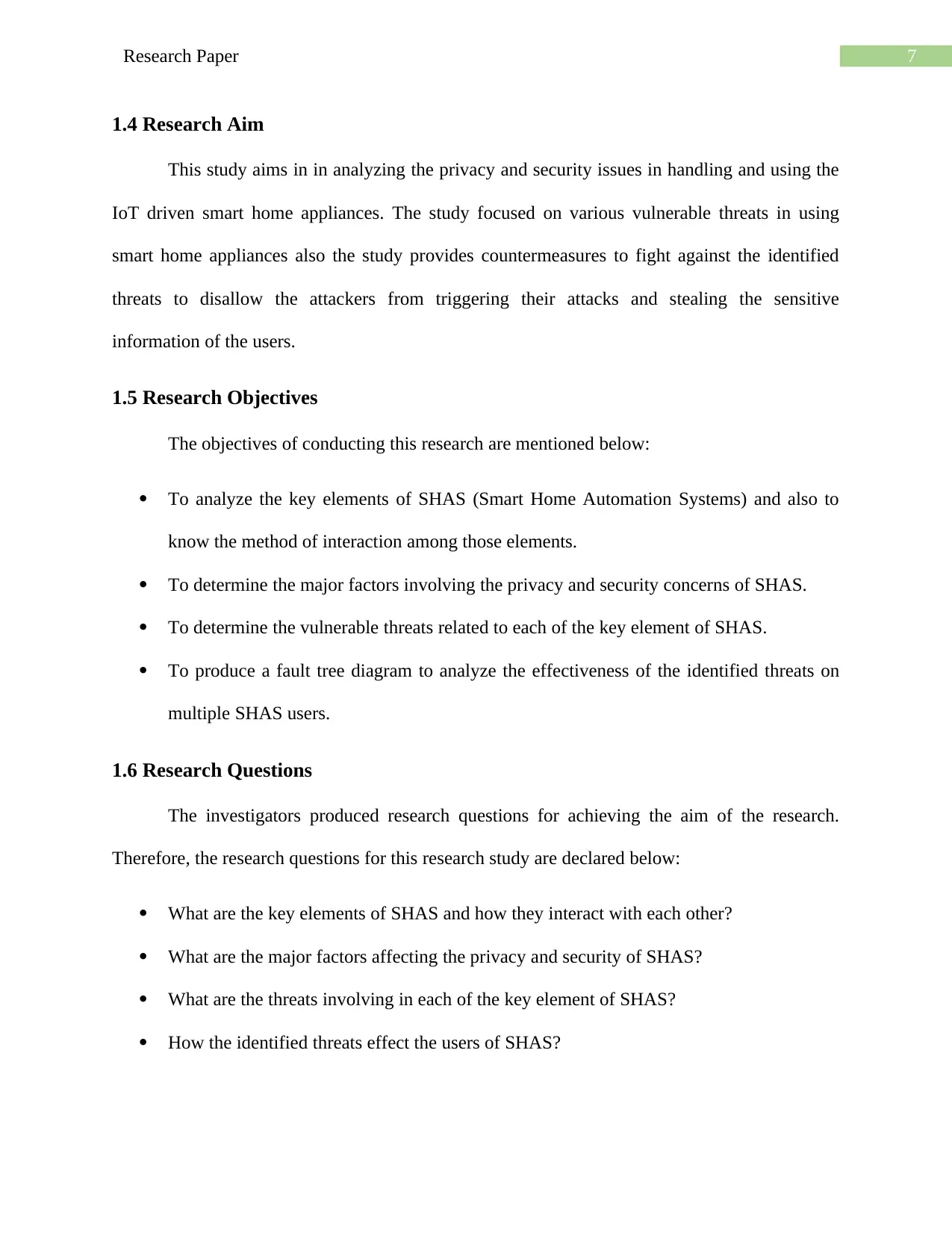
7Research Paper
1.4 Research Aim
This study aims in in analyzing the privacy and security issues in handling and using the
IoT driven smart home appliances. The study focused on various vulnerable threats in using
smart home appliances also the study provides countermeasures to fight against the identified
threats to disallow the attackers from triggering their attacks and stealing the sensitive
information of the users.
1.5 Research Objectives
The objectives of conducting this research are mentioned below:
To analyze the key elements of SHAS (Smart Home Automation Systems) and also to
know the method of interaction among those elements.
To determine the major factors involving the privacy and security concerns of SHAS.
To determine the vulnerable threats related to each of the key element of SHAS.
To produce a fault tree diagram to analyze the effectiveness of the identified threats on
multiple SHAS users.
1.6 Research Questions
The investigators produced research questions for achieving the aim of the research.
Therefore, the research questions for this research study are declared below:
What are the key elements of SHAS and how they interact with each other?
What are the major factors affecting the privacy and security of SHAS?
What are the threats involving in each of the key element of SHAS?
How the identified threats effect the users of SHAS?
1.4 Research Aim
This study aims in in analyzing the privacy and security issues in handling and using the
IoT driven smart home appliances. The study focused on various vulnerable threats in using
smart home appliances also the study provides countermeasures to fight against the identified
threats to disallow the attackers from triggering their attacks and stealing the sensitive
information of the users.
1.5 Research Objectives
The objectives of conducting this research are mentioned below:
To analyze the key elements of SHAS (Smart Home Automation Systems) and also to
know the method of interaction among those elements.
To determine the major factors involving the privacy and security concerns of SHAS.
To determine the vulnerable threats related to each of the key element of SHAS.
To produce a fault tree diagram to analyze the effectiveness of the identified threats on
multiple SHAS users.
1.6 Research Questions
The investigators produced research questions for achieving the aim of the research.
Therefore, the research questions for this research study are declared below:
What are the key elements of SHAS and how they interact with each other?
What are the major factors affecting the privacy and security of SHAS?
What are the threats involving in each of the key element of SHAS?
How the identified threats effect the users of SHAS?
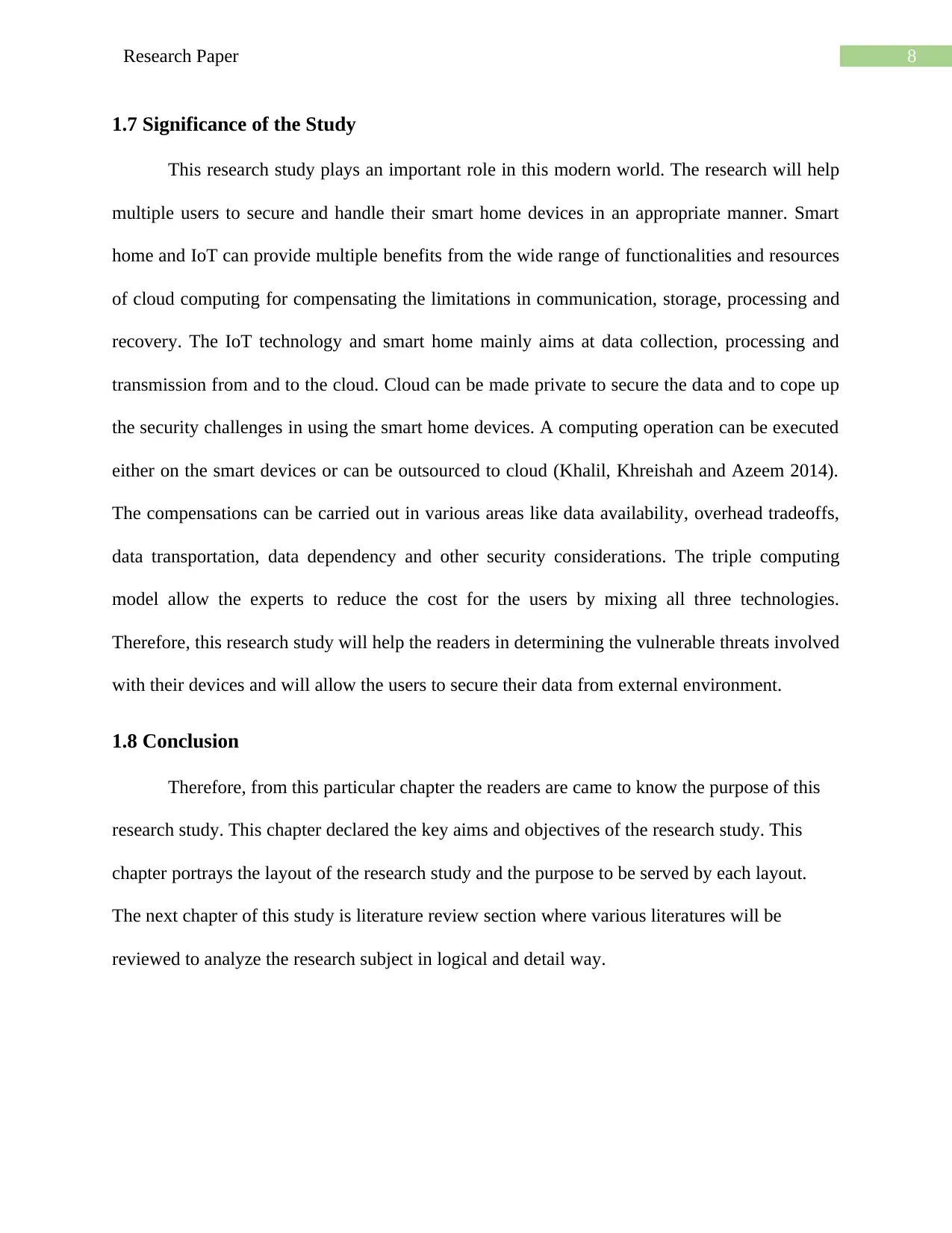
8Research Paper
1.7 Significance of the Study
This research study plays an important role in this modern world. The research will help
multiple users to secure and handle their smart home devices in an appropriate manner. Smart
home and IoT can provide multiple benefits from the wide range of functionalities and resources
of cloud computing for compensating the limitations in communication, storage, processing and
recovery. The IoT technology and smart home mainly aims at data collection, processing and
transmission from and to the cloud. Cloud can be made private to secure the data and to cope up
the security challenges in using the smart home devices. A computing operation can be executed
either on the smart devices or can be outsourced to cloud (Khalil, Khreishah and Azeem 2014).
The compensations can be carried out in various areas like data availability, overhead tradeoffs,
data transportation, data dependency and other security considerations. The triple computing
model allow the experts to reduce the cost for the users by mixing all three technologies.
Therefore, this research study will help the readers in determining the vulnerable threats involved
with their devices and will allow the users to secure their data from external environment.
1.8 Conclusion
Therefore, from this particular chapter the readers are came to know the purpose of this
research study. This chapter declared the key aims and objectives of the research study. This
chapter portrays the layout of the research study and the purpose to be served by each layout.
The next chapter of this study is literature review section where various literatures will be
reviewed to analyze the research subject in logical and detail way.
1.7 Significance of the Study
This research study plays an important role in this modern world. The research will help
multiple users to secure and handle their smart home devices in an appropriate manner. Smart
home and IoT can provide multiple benefits from the wide range of functionalities and resources
of cloud computing for compensating the limitations in communication, storage, processing and
recovery. The IoT technology and smart home mainly aims at data collection, processing and
transmission from and to the cloud. Cloud can be made private to secure the data and to cope up
the security challenges in using the smart home devices. A computing operation can be executed
either on the smart devices or can be outsourced to cloud (Khalil, Khreishah and Azeem 2014).
The compensations can be carried out in various areas like data availability, overhead tradeoffs,
data transportation, data dependency and other security considerations. The triple computing
model allow the experts to reduce the cost for the users by mixing all three technologies.
Therefore, this research study will help the readers in determining the vulnerable threats involved
with their devices and will allow the users to secure their data from external environment.
1.8 Conclusion
Therefore, from this particular chapter the readers are came to know the purpose of this
research study. This chapter declared the key aims and objectives of the research study. This
chapter portrays the layout of the research study and the purpose to be served by each layout.
The next chapter of this study is literature review section where various literatures will be
reviewed to analyze the research subject in logical and detail way.
⊘ This is a preview!⊘
Do you want full access?
Subscribe today to unlock all pages.

Trusted by 1+ million students worldwide
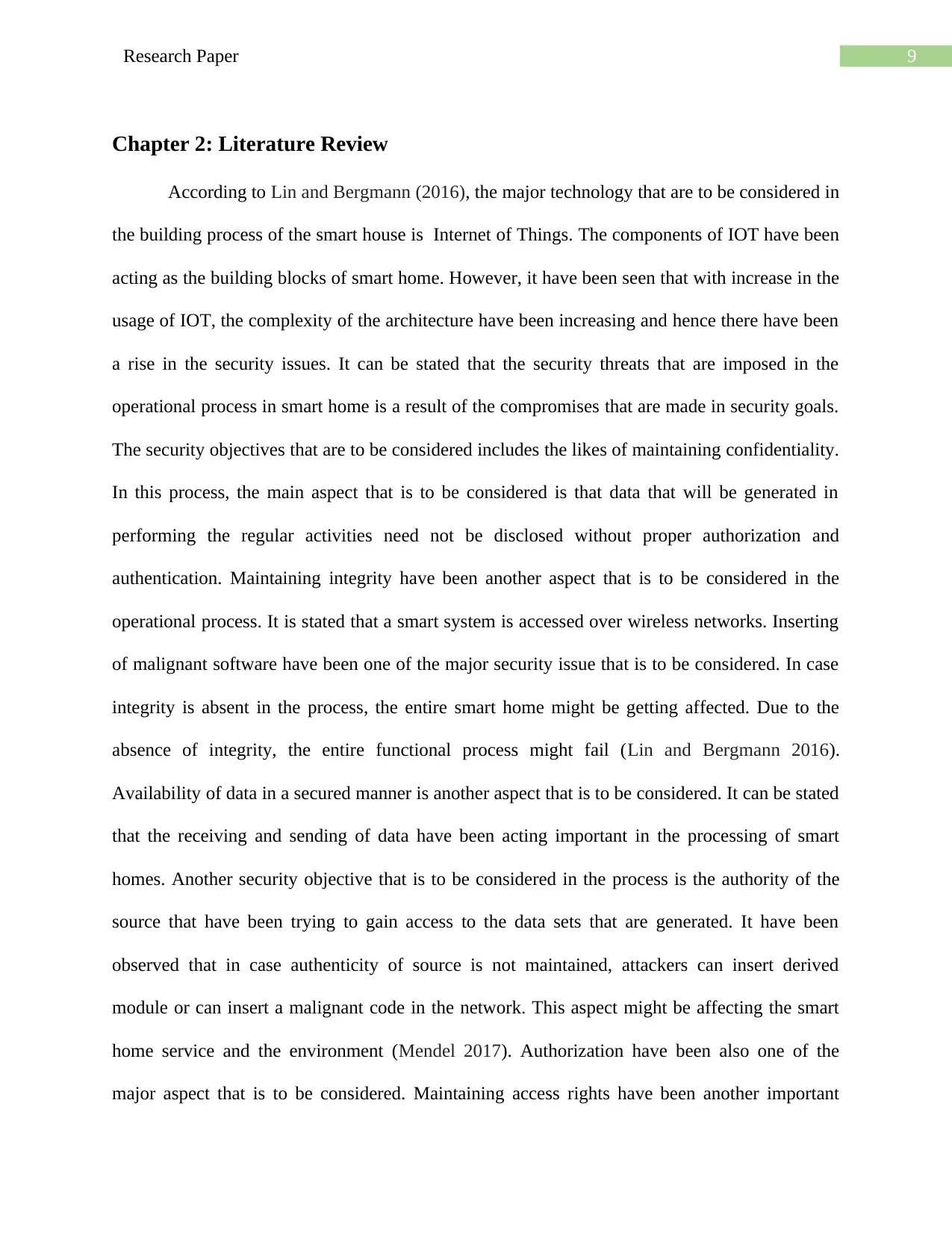
9Research Paper
Chapter 2: Literature Review
According to Lin and Bergmann (2016), the major technology that are to be considered in
the building process of the smart house is Internet of Things. The components of IOT have been
acting as the building blocks of smart home. However, it have been seen that with increase in the
usage of IOT, the complexity of the architecture have been increasing and hence there have been
a rise in the security issues. It can be stated that the security threats that are imposed in the
operational process in smart home is a result of the compromises that are made in security goals.
The security objectives that are to be considered includes the likes of maintaining confidentiality.
In this process, the main aspect that is to be considered is that data that will be generated in
performing the regular activities need not be disclosed without proper authorization and
authentication. Maintaining integrity have been another aspect that is to be considered in the
operational process. It is stated that a smart system is accessed over wireless networks. Inserting
of malignant software have been one of the major security issue that is to be considered. In case
integrity is absent in the process, the entire smart home might be getting affected. Due to the
absence of integrity, the entire functional process might fail (Lin and Bergmann 2016).
Availability of data in a secured manner is another aspect that is to be considered. It can be stated
that the receiving and sending of data have been acting important in the processing of smart
homes. Another security objective that is to be considered in the process is the authority of the
source that have been trying to gain access to the data sets that are generated. It have been
observed that in case authenticity of source is not maintained, attackers can insert derived
module or can insert a malignant code in the network. This aspect might be affecting the smart
home service and the environment (Mendel 2017). Authorization have been also one of the
major aspect that is to be considered. Maintaining access rights have been another important
Chapter 2: Literature Review
According to Lin and Bergmann (2016), the major technology that are to be considered in
the building process of the smart house is Internet of Things. The components of IOT have been
acting as the building blocks of smart home. However, it have been seen that with increase in the
usage of IOT, the complexity of the architecture have been increasing and hence there have been
a rise in the security issues. It can be stated that the security threats that are imposed in the
operational process in smart home is a result of the compromises that are made in security goals.
The security objectives that are to be considered includes the likes of maintaining confidentiality.
In this process, the main aspect that is to be considered is that data that will be generated in
performing the regular activities need not be disclosed without proper authorization and
authentication. Maintaining integrity have been another aspect that is to be considered in the
operational process. It is stated that a smart system is accessed over wireless networks. Inserting
of malignant software have been one of the major security issue that is to be considered. In case
integrity is absent in the process, the entire smart home might be getting affected. Due to the
absence of integrity, the entire functional process might fail (Lin and Bergmann 2016).
Availability of data in a secured manner is another aspect that is to be considered. It can be stated
that the receiving and sending of data have been acting important in the processing of smart
homes. Another security objective that is to be considered in the process is the authority of the
source that have been trying to gain access to the data sets that are generated. It have been
observed that in case authenticity of source is not maintained, attackers can insert derived
module or can insert a malignant code in the network. This aspect might be affecting the smart
home service and the environment (Mendel 2017). Authorization have been also one of the
major aspect that is to be considered. Maintaining access rights have been another important
Paraphrase This Document
Need a fresh take? Get an instant paraphrase of this document with our AI Paraphraser
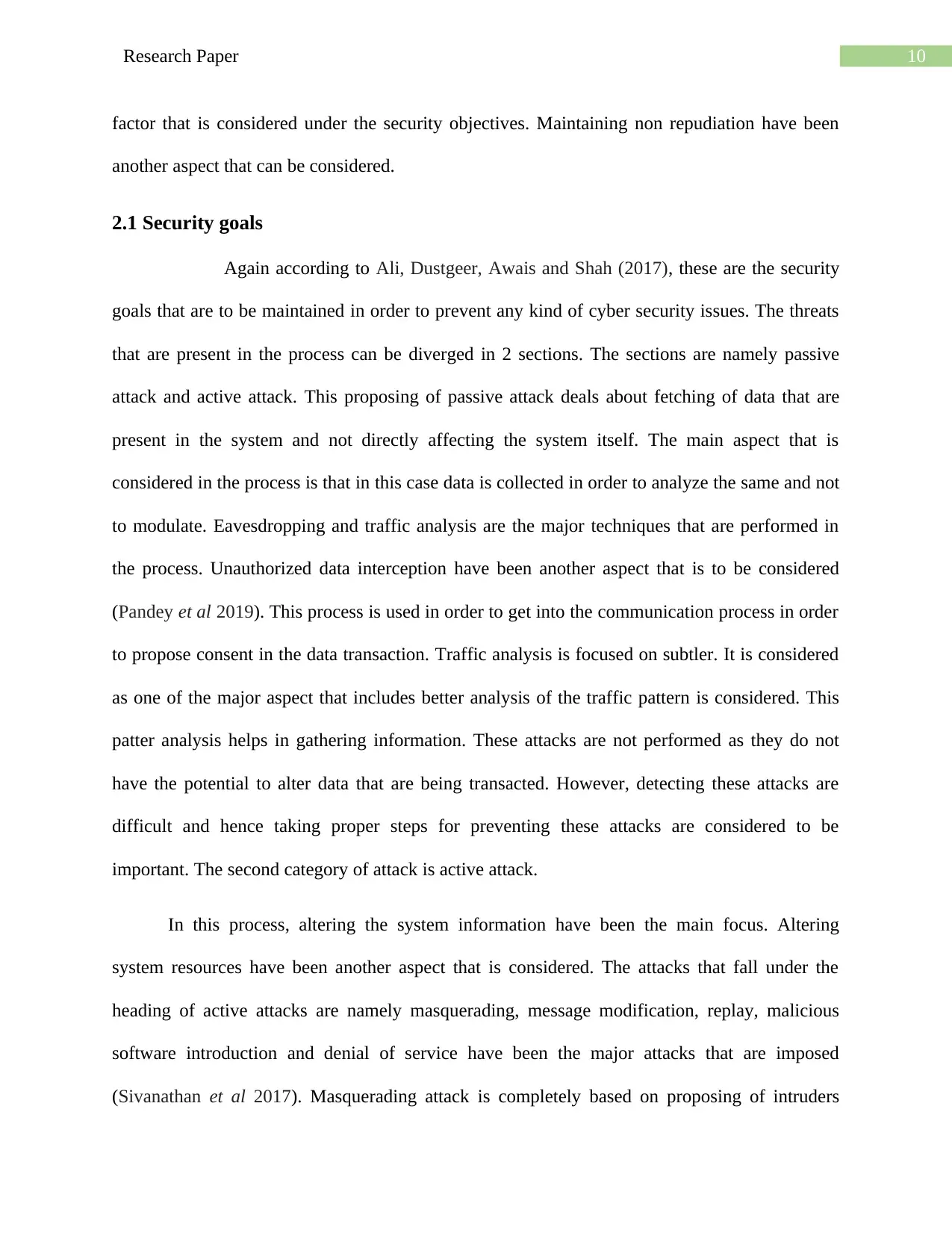
10Research Paper
factor that is considered under the security objectives. Maintaining non repudiation have been
another aspect that can be considered.
2.1 Security goals
Again according to Ali, Dustgeer, Awais and Shah (2017), these are the security
goals that are to be maintained in order to prevent any kind of cyber security issues. The threats
that are present in the process can be diverged in 2 sections. The sections are namely passive
attack and active attack. This proposing of passive attack deals about fetching of data that are
present in the system and not directly affecting the system itself. The main aspect that is
considered in the process is that in this case data is collected in order to analyze the same and not
to modulate. Eavesdropping and traffic analysis are the major techniques that are performed in
the process. Unauthorized data interception have been another aspect that is to be considered
(Pandey et al 2019). This process is used in order to get into the communication process in order
to propose consent in the data transaction. Traffic analysis is focused on subtler. It is considered
as one of the major aspect that includes better analysis of the traffic pattern is considered. This
patter analysis helps in gathering information. These attacks are not performed as they do not
have the potential to alter data that are being transacted. However, detecting these attacks are
difficult and hence taking proper steps for preventing these attacks are considered to be
important. The second category of attack is active attack.
In this process, altering the system information have been the main focus. Altering
system resources have been another aspect that is considered. The attacks that fall under the
heading of active attacks are namely masquerading, message modification, replay, malicious
software introduction and denial of service have been the major attacks that are imposed
(Sivanathan et al 2017). Masquerading attack is completely based on proposing of intruders
factor that is considered under the security objectives. Maintaining non repudiation have been
another aspect that can be considered.
2.1 Security goals
Again according to Ali, Dustgeer, Awais and Shah (2017), these are the security
goals that are to be maintained in order to prevent any kind of cyber security issues. The threats
that are present in the process can be diverged in 2 sections. The sections are namely passive
attack and active attack. This proposing of passive attack deals about fetching of data that are
present in the system and not directly affecting the system itself. The main aspect that is
considered in the process is that in this case data is collected in order to analyze the same and not
to modulate. Eavesdropping and traffic analysis are the major techniques that are performed in
the process. Unauthorized data interception have been another aspect that is to be considered
(Pandey et al 2019). This process is used in order to get into the communication process in order
to propose consent in the data transaction. Traffic analysis is focused on subtler. It is considered
as one of the major aspect that includes better analysis of the traffic pattern is considered. This
patter analysis helps in gathering information. These attacks are not performed as they do not
have the potential to alter data that are being transacted. However, detecting these attacks are
difficult and hence taking proper steps for preventing these attacks are considered to be
important. The second category of attack is active attack.
In this process, altering the system information have been the main focus. Altering
system resources have been another aspect that is considered. The attacks that fall under the
heading of active attacks are namely masquerading, message modification, replay, malicious
software introduction and denial of service have been the major attacks that are imposed
(Sivanathan et al 2017). Masquerading attack is completely based on proposing of intruders
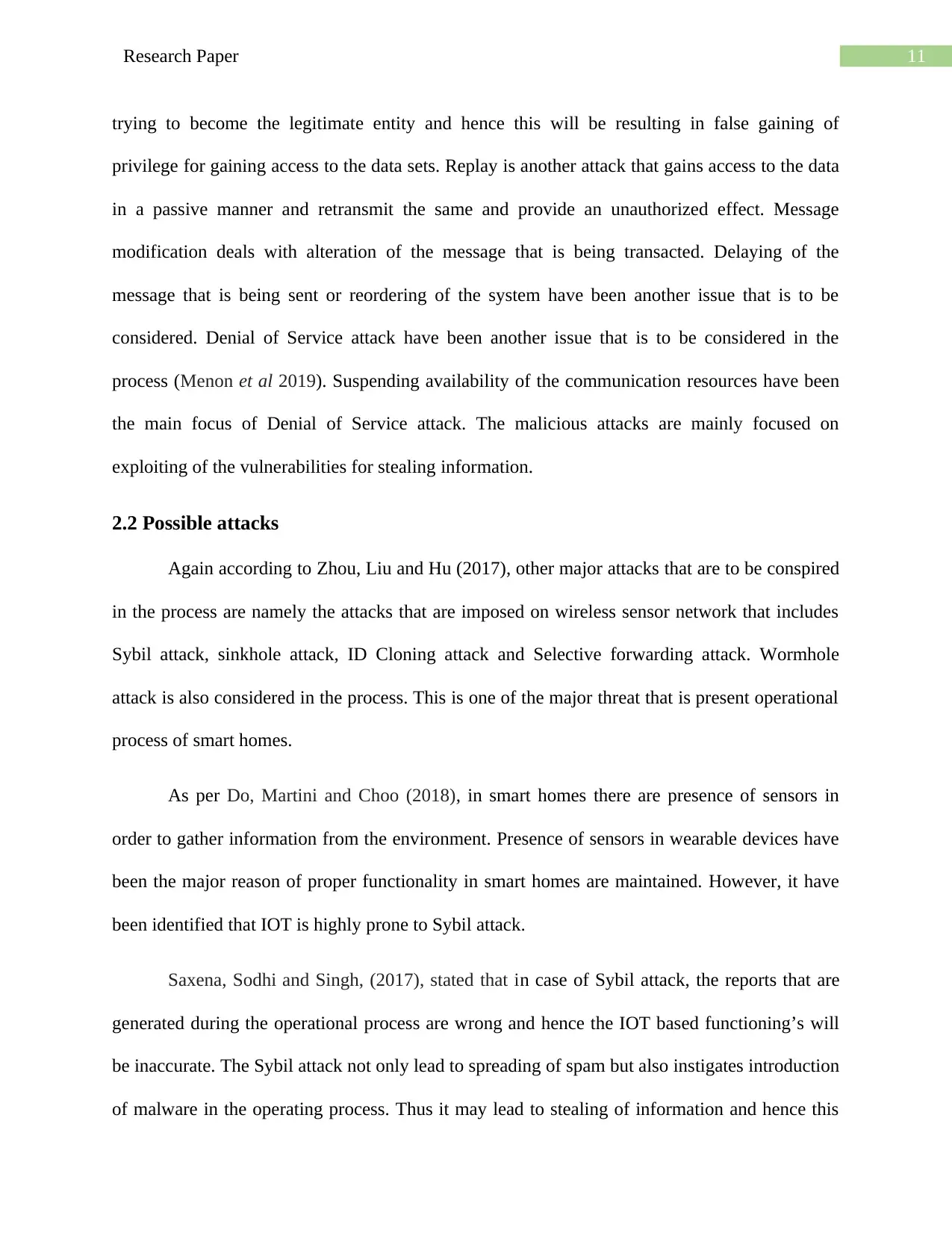
11Research Paper
trying to become the legitimate entity and hence this will be resulting in false gaining of
privilege for gaining access to the data sets. Replay is another attack that gains access to the data
in a passive manner and retransmit the same and provide an unauthorized effect. Message
modification deals with alteration of the message that is being transacted. Delaying of the
message that is being sent or reordering of the system have been another issue that is to be
considered. Denial of Service attack have been another issue that is to be considered in the
process (Menon et al 2019). Suspending availability of the communication resources have been
the main focus of Denial of Service attack. The malicious attacks are mainly focused on
exploiting of the vulnerabilities for stealing information.
2.2 Possible attacks
Again according to Zhou, Liu and Hu (2017), other major attacks that are to be conspired
in the process are namely the attacks that are imposed on wireless sensor network that includes
Sybil attack, sinkhole attack, ID Cloning attack and Selective forwarding attack. Wormhole
attack is also considered in the process. This is one of the major threat that is present operational
process of smart homes.
As per Do, Martini and Choo (2018), in smart homes there are presence of sensors in
order to gather information from the environment. Presence of sensors in wearable devices have
been the major reason of proper functionality in smart homes are maintained. However, it have
been identified that IOT is highly prone to Sybil attack.
Saxena, Sodhi and Singh, (2017), stated that in case of Sybil attack, the reports that are
generated during the operational process are wrong and hence the IOT based functioning’s will
be inaccurate. The Sybil attack not only lead to spreading of spam but also instigates introduction
of malware in the operating process. Thus it may lead to stealing of information and hence this
trying to become the legitimate entity and hence this will be resulting in false gaining of
privilege for gaining access to the data sets. Replay is another attack that gains access to the data
in a passive manner and retransmit the same and provide an unauthorized effect. Message
modification deals with alteration of the message that is being transacted. Delaying of the
message that is being sent or reordering of the system have been another issue that is to be
considered. Denial of Service attack have been another issue that is to be considered in the
process (Menon et al 2019). Suspending availability of the communication resources have been
the main focus of Denial of Service attack. The malicious attacks are mainly focused on
exploiting of the vulnerabilities for stealing information.
2.2 Possible attacks
Again according to Zhou, Liu and Hu (2017), other major attacks that are to be conspired
in the process are namely the attacks that are imposed on wireless sensor network that includes
Sybil attack, sinkhole attack, ID Cloning attack and Selective forwarding attack. Wormhole
attack is also considered in the process. This is one of the major threat that is present operational
process of smart homes.
As per Do, Martini and Choo (2018), in smart homes there are presence of sensors in
order to gather information from the environment. Presence of sensors in wearable devices have
been the major reason of proper functionality in smart homes are maintained. However, it have
been identified that IOT is highly prone to Sybil attack.
Saxena, Sodhi and Singh, (2017), stated that in case of Sybil attack, the reports that are
generated during the operational process are wrong and hence the IOT based functioning’s will
be inaccurate. The Sybil attack not only lead to spreading of spam but also instigates introduction
of malware in the operating process. Thus it may lead to stealing of information and hence this
⊘ This is a preview!⊘
Do you want full access?
Subscribe today to unlock all pages.

Trusted by 1+ million students worldwide
1 out of 26
Related Documents
Your All-in-One AI-Powered Toolkit for Academic Success.
+13062052269
info@desklib.com
Available 24*7 on WhatsApp / Email
![[object Object]](/_next/static/media/star-bottom.7253800d.svg)
Unlock your academic potential
Copyright © 2020–2025 A2Z Services. All Rights Reserved. Developed and managed by ZUCOL.





